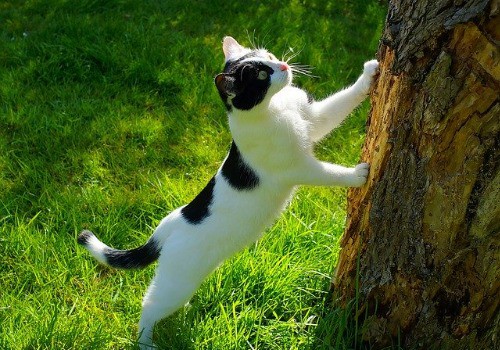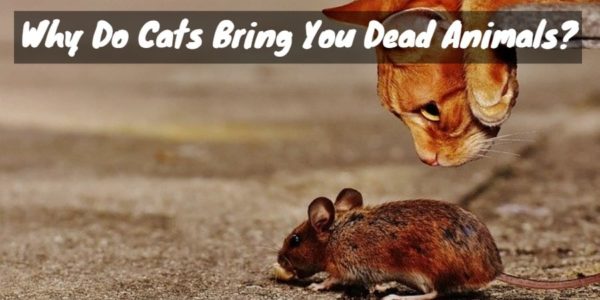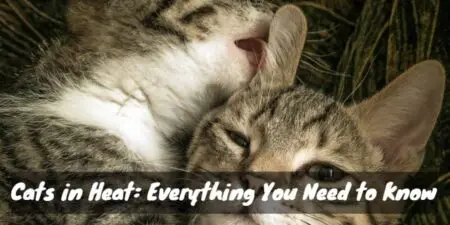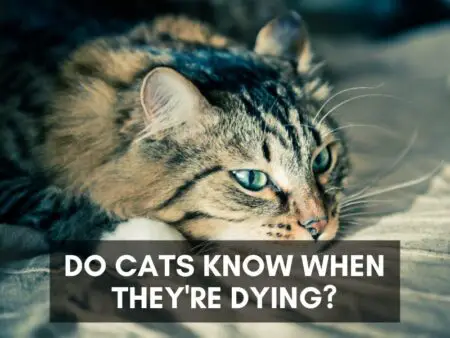In a cat’s mind, there is no greater way of telling their human they love them than bringing them a gift. Unfortunately, that gift is quite often in the form of a dead or dying mouse or another small animal. The look of pride on their face comes close to matching the look of abject horror on yours.
Although today’s kitties are mostly tame and loving, it is important to remember that their most basic instincts come from the fact that they are inherently hunters at heart. A female cat will teach her young to hunt. When a female is spayed, her natural instinct is still to hunt her prey and present it to her family.
Natural Born Predators

Cats are predators. They are natural-born hunters. Their larger counterparts, the wildcats, are great examples of the inherent hunting gene found in the species.
Even though our pets are tame, they still have their ancestral urge to hunt and present. Cats are pack animals and it is the job of the females to hunt food for the rest of the pack. Just as in the previous generations of animals, the mother cat teaches her kittens how to hunt.
When an indoor kitty doesn’t have the means or access to hunting smaller animals, they still have the urge to hunt. While they will still bring their human gifts though, those gifts tend to be their toys and not live animals.
[amazon bestseller=”cat hunt toy”]
Unfortunately, cats will not always wait until their gift is dead. Many a cat owner has been presented with a live mouse, bird or squirrel. Usually, if that animal is released and your cat still has access to it, it will most likely arrive on your doorstep or perhaps even your shoe.
Domesticated Cats Through History
Since the first documentation of the domesticated feline over 10,000 years ago, cats have often been kept solely for the purpose of hunting mice and other small animals in order to rid their owner’s homes or farms of the pests. This talent comes naturally to them.
Ancient Egypt
In Ancient Egypt, cats were not only worshipped but held in very high esteem. If a human injured or killed a cat, severe penalties ensued. The Goddess Bastet was often depicted with the body of a human female and the head of a cat. While there were several Gods and Goddesses in Ancient Egypt religion who were depicted as some breed of feline, Bastet was the first to be depicted as a domesticated cat.
Festivals for Bastet were known to be the largest and most elaborate. Many relics from the time were small statues of cats that were probably gifted to the Goddess Bastet. In the areas around her temple in the northern city of Bubastis, there were even burial grounds from which numerous mummified remains of domestic house cats have been found.
Cats of all sizes were viewed as protectors in the house of Pharoah. Mythology tells us that this worship may have begun when a cat killed a poisonous snake that was poised to strike a high ranking human. Cats were kept in the palace to kill scorpions, snakes and small rodents and were seen as warding off evil spirits.
The mummification of cats is thought to have been for the purpose of making offers to the various deities who were depicted with feline characteristics. This worship extended from lions and panthers, down to the smallest domesticated breeds. Ironically, the mummified remains showed signs that the cats were killed before they reached the age of 2 years old with their primary cause of death being strangulation.
[amazon bestseller=”cat automatic toy”]
Other Religious Connections

The practice of worship and mummification of cats ended with the advent of Christianity. It is rumored that when Jesus was born, it took a cat jumping into the manger to comfort the infant. It is said that the ‘M’ design seen on the heads of many cats is because his mother was so grateful that she scratched the cats head in thanks.
Cats are revered by members of Islam as it is thought that the Prophet Muhammad kept a number of cats as pets. It is said that he would even leave his cloak behind if there was a cat sitting on it. Modern Muslims hold cats in high esteem to be more like the Prophet Muhammed.
The Renaissance
Unfortunately, cats were also associated with witches. During the 14th century, in Europe, thousands of cats were killed. It is thought that this decrease in their population contributed significantly to the Black Death as the vermin carrying the disease became prolific without their natural predator.
Finally, a medieval king of Wales made it illegal to kill cats and once again their population was allowed to flourish. Other countries looked upon cats quite differently. The Vikings revered their cats due to their rat-killing abilities
Modern Era Cats
Modern era cats and their behavior started being the subject of research studies in the 14th century. Many researchers have long been fascinated with their stand-offish attitudes. Once they understood the cat better they could easily see the value of them.
Some domesticated cats are still kept around for their hunting skills. Farmers and ranchers often keep barn cats around to rid their barns and other outlying buildings of rodents such as mice and rats. No matter how tame, their urge to hunt and to bring home their prey will always be strong.
When we see the common behavior of kitty sitting in the window chattering at the birds, reality says that the cat is stalking its prey by talking to them. Perhaps they believe that if they make bird-like sounds that their prey might be able to come to them. They sometimes seem oblivious to the fact that there is a window between them and their prey.
Since cats as a population are capable of killing billions of rodents every year, they are responsible for keeping the population of rodents down. This trait makes them very attractive should your property have a problem with mice or rats. It is this instinct that made them popular on ships throughout the ages.
Cultural Views Of Cats

In the United States, black cats are held by many to be bad luck. At the same time, in England, black cats are believed to be good luck. If a black cat entered a ship or a home, it was thought to be bringing good luck there.
[amazon bestseller=”cat mouse toy electronic”]
Cats in Japan are considered by many to be good luck charms. There is even a Japanese Island where cats outnumber humans. Much of the human population of that island is there solely for the purpose of taking care of the cats. China is also known to generally pamper their feline pets.
Cats have always played a part in Russian history. There is a community of cats that live in the Winter Palace in St. Petersburg who even have their own staff of humans whose sole responsibility is to take care of them. Russian cats have always been held in high esteem as a comfort for their humans.
In Ancient Greece and Rome, cats were quite rarely found as pets as other animals such as ferrets and weasels were the preferred pet for rodent control. History through drawings, sculptures and other artifacts very rarely depicted cats in a positive light. Cats were eventually brought indoors to replace the ferrets and weasels giving them, once again, a reputation for being good house pets.
Cats don’t always get a positive reputation. Aside from the belief that black cats were bad luck or the familiars of witches, there was a long-held belief that if a cat was allowed around a newborn child that the cat would be capable of smothering the child and stealing its breath.
Gift Giving Behaviors
There are many different behavioral theories as to why cats bring their humans gifts of dead animals. One theory is that the cats view their humans as being unable to hunt leaving it up to the kitty to bring home the prey. They view their humans as other cats who they need to gift with the tiny carcasses of their unsuspecting prey.
Just due to their natural instincts, mother cats teach their kittens to hunt. It is thought by many that spayed females will be more of a predator than her unswayed counterparts. Studies show that female cats are more likely than males to bring home the prey.
Still, another behavioral theory holds that the reason that cats gift us with dead animals is to thank us for being their caretakers. This is their way of thanking us for providing them with a home and food. These animals who are not as used to hunting in the wild are just as likely to present us with live animals as with dead ones.

Another theory holds that the reason that cats bring us these offerings is a way to get us to play with them. They might even want us to join them as they hunt for prey in the only environment they know: the inside of the house. Instead of presenting us with dead animals, they will present us with their toys.
This explains why the most preferred toys for cats are the fuzzy mouses that can be purchased in every size or shape. Their toy looks like the prey that they so desperately need to present to us. These toys are obviously the preferred gift as far as humans are concerned.
There is a danger to allowing them to gift us with dead animals. Most of their prey is vermin who can carry dangerous diseases such as rabies. Other problems relate to the fact that the wildlife being gifted might bring another less attractive gift in the forms of fleas.
[amazon bestseller=”cat fuzzy mouse toy”]
Outdoor cats are much more likely to gift us with dead animals. It is the dangers related to diseases and fleas that make it even more important for domesticated cats to be kept indoors. A fake dead mouse is far more attractive a gift to that of a real one.
Since cats view their humans as a different breed of cat, these offerings are always well intentioned. So despite our horror at the gift of a dead animal, we must realize that this is who a cat really is. To them, they are presenting you with the most generous gift in the world.
"In ancient times cats were worshipped as gods; they have not forgotten this."
-- Terry Pratchett






Just so you realize, mice and rats, while they are vermin, are very nearly never transmitters of rabies. The same goes for squirrels, chipmunks, rabbits and possums. Birds and snakes do not transmit rabies either. Possums’ body temperature and immune systems virtually preclude them from carrying it.
I’m not saying one should go out and handle the bloody corpse of a mouse that a cat killed and brought home, but they also are not considered a vector of rabies transmission either.
There is enough fear-mongering in the world already. Worrying that Felix has brought rabies home with him in the form of a dead mouse dumped on the front stoop should not be one of those fears.